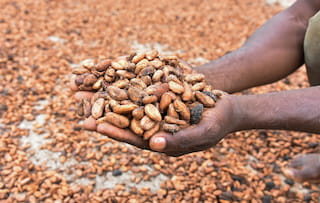When Cocoa and Forest Preservation go hand in hand in Cameroon

This article was originally published in Le Monde
Co-funded by IDH and Telcar Cocoa Ltd, the Ascokyb project in Cameroon aims to help farmers diversify their income by planting high-value trees in their cocoa system, while sustainably managing their community forests.
Ascokyb means “Kombé Yallongo and Bikong Community Association”, and is inspired by the name of the three villages in which the project is located. Ascokyp helps producers join for group sales and get better prices for their productions.
The French daily newspaper, Le Monde, went to the field and met with these producers. One example is Roland Ntima, a cocoa farmer based Yallongo, who revealed he expects up to five million CFA francs (€7623) at the end of the season, thanks to group sales.
The project also aims to train 500 farmers on agroforestry so that they can implement it independently and run it as a business. Community members expect to produce 30,000 tree seedlings. The Daily confirmed that six community tree nurseries have emerged and three businesses have already been created in the form of a common initiative group (GIC).
The project helps farmers conserve the community forest while increasing their income. That’s why they were trained on how to set up and manage the tree nursery, how to nurture these plants , and how to integrate them into their fields to increase the production without cutting trees.
Cocoa without deforestation and social inclusion are key elements within all the projects implemented by IDH in Cameroon. Women of the area now earn money from non-timber forest products like Njangsang, a local seed that serves as a spice.
Speaking on behalf of women of Ossembe, Ms. Nga said:
Cocoa cultivation remains overwhelmingly a male activity. But our husbands are starting to be jealous of the njansang.Through group sales by the GIC, women are now selling a kilo of spices for 2,000 CFA francs.
And as Le Monde stated:
It is enough to spice up everyday life and free cocoa farmers a little from the variability of weather and markets.Read the full article in Le Monde here
